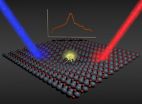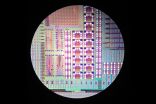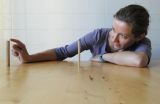(Press-News.org) Navigating through a cluttered environment at high speed is among the greatest challenges in biology - and it's one virtually all birds achieve with ease.
It's a feat David Williams hopes to understand.
A former post-doctoral fellow in the lab of Andrew Biewener, the Charles P. Lyman Professor of Biology, and a current post-doc at the University of Washington, Williams is the lead author of a study that shows birds use two highly stereotyped postures to avoid obstacles in flight. The study could open the door to new ways to program drones and other unmanned aerial vehicles to avoid similar obstacles. The study is described in a paper published earlier this month in Proceedings of the National Academy of Sciences.
"This was somewhat surprising to us," Williams said, of the results. "In lower order animals like insects we think of these very stereotyped motor programs where you stimulate your muscle, and the passive dynamics of your exoskeleton or the tendons attached to that muscle control most of the motion.
"But when you look at higher-order animals, it's common to expect that those motor programs are going to be more complex, and there's going to be more subtle gradations in those programs, so it was surprising to see a very high-order animal like a bird using very simple motor programs. Biology is optimized to be just good enough to work, so what that indicates is those are very effective motor programs."
While most other research into bird flight has focused on what scientists call "clear-sky" flying, Williams' study was focused on understanding how, once birds identify gaps between obstacles - whether they are buildings, cars, homes or trees - adjust their in-flight posture to squeeze through those spaces.
"A big part of biological motion is energy minimization and robustness," he explained. "You want to be able to get around without exhausting yourself, and if you do hit something, you don't want it to be something that's unrecoverable. You don't want to fall to the ground, or to break a wing."
The expectation, Williams said, was that birds would adopt a myriad of different postures to allow them to fit through obstacles of varying sizes. The reality, however, was far more interesting.
"What we actually found was there are two very distinct, stereotyped postures that are adopted," he said. "We thought there would be body rotation, we though there might be intermediate stages where they would pull their wings in a little bit, we thought there would be stages where they might have one wing up and one down. We thought it would be catch-as-catch-can, and it's not."
In the first posture - what Williams calls "wings paused" - the birds wings are held wide out, at the top of the upswing of their wing beat. In the second, the birds tuck their wings back against their body, almost as if they were perched on a branch.
"The paused posture...interrupts their wing beat cycle for shorter periods of time, so they tend to lose less height, and their wings are ready to hit the air running, so to speak," Williams said. "We thought maybe they were using the ballistic posture in cases where they want to get smaller, but it doesn't actually make them much smaller from a forward angle. What it does do is reduce the amount they're going to rotate or be disrupted if they do collide with anything."
To understand the birds' in flight postures, Williams and colleagues built a 20-meter long flight corridor - essentially an obstacle course consisting of a number of vertical poles - for birds to fly through.
Researchers then fitted pigeons with small backpacks that powered a series of infrared LEDs, which were placed along the bird's back, at their wingtips, their wrist and on their head. As the birds flew through the corridor, the LEDs were tracked by an array of five high-speed cameras, allowing researchers to precisely determine their posture.
Going forward, Williams said, researchers hope to expand the study to include horizontal obstacles similar to tree limbs, but the findings in the current study may offer new insight into how unmanned aerial vehicles could be programmed to avoid obstacles.
"When most people think about drones they think about quad-copters...people are getting better at controlling them through very narrow and complex obstacle courses, but there are experimental flight devices that feature adjustable wing aspect ratios," Williams said. "This suggests that if we can build the brains into the material structure of an object, rather than into the computation controlling the object...we can change the stability through that mechanism."
INFORMATION:
This news release is available in German.
Researchers of Karlsruhe Institute of Technology (KIT) have unveiled an important step in the conversion of light into storable energy: Together with scientists of the Fritz Haber Institute in Berlin and the Aalto University in Helsinki/Finland, they studied the formation of so-called polarons in zinc oxide. The pseudoparticles travel through the photoactive material until they are converted into electrical or chemical energy at an interface. Their findings that are of relevance to photovoltaics among others are now published ...
A Spanish-led team of European researchers at the University of Cambridge has created an electronic device so accurate that it can detect the charge of a single electron in less than one microsecond. It has been dubbed the 'gate sensor' and could be applied in quantum computers of the future to read information stored in the charge or spin of a single electron.
In the same Cambridge laboratory in the United Kingdom where the British physicist J.J. Thomson discovered the electron in 1897, European scientists have just developed a new ultra-sensitive electrical-charge sensor ...
How long is the way from the city hall to the train station? When we estimate distances, something curious happens: short distances seem longer, and long distances shorter than they really are. Similar biases occur during judgments of volume, brightness or time. Psychologists call this phenomenon Vierordt's law. Its independence of the involved sensory systems suggests that our brain possesses universal principles for the assessment of physical quantities. However, where do the characteristic estimation biases stem from? In collaboration with colleagues from Zurich, neuroscientists ...
It's a common dilemma faced by many working parents: your child has a cough or a cold, do you send them to nursery?
Researchers from the University of Bristol have, for the first time, investigated the process of decision-making that parents go through when faced with this situation. The research, published in The Journal of Public Health, reports that parents viewed coughs and colds as less serious and not as contagious as sickness and diarrhoea symptoms.
This resulted in many parents sending their child to daycare with a respiratory tract infection (RTI), which can ...
In response to an article published by Chinese scientists describing research that used gene editing technologies in human embryos, the International Society for Stem Cell Research (ISSCR) has again called for a moratorium on attempts at human clinical germline genome editing while extensive scientific analysis of the potential risks is conducted, along with broad public discussion of the societal and ethical implications. The research article, entitled "CRISPR/Cas9-mediated Gene Editing in Human Tripronuclear Zygotes," was published online on April 18 in the scientific ...
Imagine a day when scientists are able to alter the DNA of organisms in the lab in the search for answers to a host of questions. Or imagine a day when doctors treat genetic disorders by administering drugs designed to alter a patient's genome.
It may sound like science fiction, but with the development of genome-editing proteins like Cas9 and CRISPR, it could one day become science fact.
Before that happens, however, scientists must overcome a number of challenges, including how to improve the specificity of these proteins- the rate at which genome-editing proteins ...
A more intellectually demanding job may be the key to living longer after developing young-onset dementia, according to health researchers.
Degeneration of the frontal and temporal parts of the brain leads to a common form of dementia affecting people under the age of 65. It results in changes in personality and behavior and problems with language, but does not affect memory.
"[Our] study suggests that having a higher occupational level protects the brain from some of the effects of this disease, allowing people to live longer after developing the disease," said Lauren ...
An international team of scientists is calling for urgent and temperature patterns in mountain regions after compiling evidence that high elevations could be warming faster than previously thought.
Without substantially better information, people risk underestimating the severity of a number of already looming environmental challenges, including water shortages and the possible extinction of some alpine flora and fauna, according to the research team, which includes Henry Diaz and Imtiaz Rangwala from CIRES, the Cooperative Institute for Research in Environmental Sciences ...
Shetland ponies' immune response to insect bites is helping scientists understand how people could be prevented from developing allergies.
The horse immune system can respond to midge bites in a way that prevents - rather than triggers - allergic reactions, researchers say.
The ponies' immune response to midge bites is similar to what happens in people with allergies, the team says. Understanding what triggers allergic reactions could help researchers come up with ways to stop people developing sensitivities.
It was previously thought that ponies which do not suffer ...
April 23, 2015, Vienna, Austria: A drug approved to treat type 2 diabetes could prove to be a powerful new treatment option for non-alcoholic steatohepatitis (NASH), according to research presented today at The International Liver CongressTM 2015. Results from a randomised controlled trial showed liraglutide met the primary endpoint of histological clearance of NASH, and a reduction in the progression of fibrosis. The research was supported by the Wellcome Trust and the NIHR.
In the Liraglutide Efficacy and Action in NASH (LEAN) trial, overweight patients with biopsy-confirmed ...



